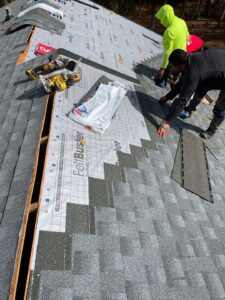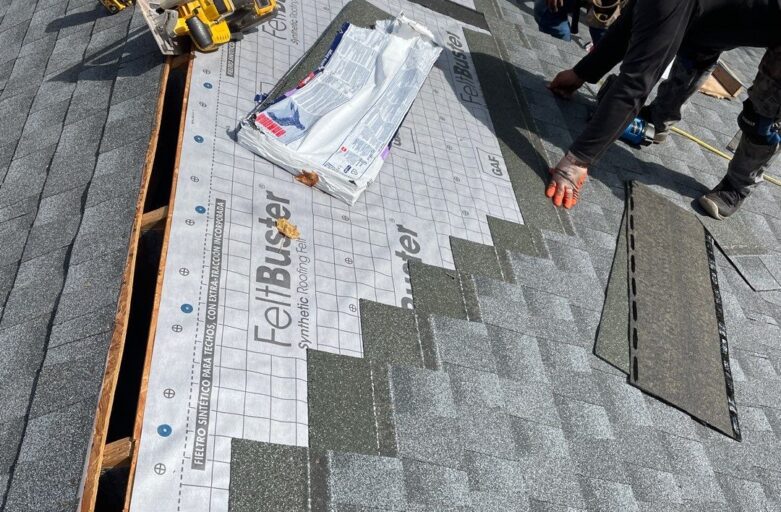The roof is one of the most critical components of a home. It shields the interior from rain, snow, sunlight, wind, and extreme temperatures.

Besides protecting the house from the elements, a good roof can add to a structure’s aesthetics. Roofs can be constructed of various materials in various styles and shapes. Visit https://redstickroofing.com/baton-rouge to learn more.
The roof is a home’s first line of defense against harsh weather. Wind, rain, snow, sleet, and bitter cold are just some elements it must battle. Keeping your roofing in good condition can help prevent severe damage and costly repairs.
Moreover, a pristine roof adds beauty to your home’s exterior and can even boost your curb appeal. It’s important to check your homeowners insurance coverage before you reroof your home. Many policies exclude damage caused by natural disasters or brutal storms, and you’ll want to make sure you’re covered. Some companies also offer additional homeowners’ insurance policies that provide extra coverage.
Aside from preventing damage to your home, a new roof can also protect your personal belongings. Make lists or videotapes of your valuables and keep them in a safe location away from your house to protect them in case of loss or damage. You may also want to consider a ridge vent, which keeps debris and rainwater from entering your attic.
Roof insulation is another essential part of roofing, especially if you live in an area with high humidity. Adding insulation to your home can help lower energy costs and prevent damage caused by moisture. Roofing contractors can help you choose the right type of insulation for your home and climate, and install it properly to ensure that it works.
Construction sites can be exposed to extreme temperatures and weather, which can be hazardous for workers. Engineered controls, such as radiant heaters, can be used to warm work areas and reduce the risk of cold stress. Additionally, employers should shield work areas from drafts and the wind to limit the effect of cold weather on workers’ bodies.
Attic Insulation
Insulation is a key component of roof installation. It helps keep your home cool in the summer, and warm in the winter, reducing energy bills. It also creates a thermal boundary that prevents hot air from moving from room to room. Almost 35% of home energy loss occurs in the attic space. Insulation and proper air sealing can help reduce that amount.
In new construction, attic insulation is installed in between the attic joists. If you’re updating an existing home, your roofer will determine whether your attic has existing insulation and what type. They’ll also inspect your attic for roof leaks, rot and rafter damage that could impact the quality of your new insulation.
You can choose from several types of insulation materials, depending on your needs and budget. Fiberglass batt insulation, also called blanket insulation, is usually the most cost-effective and easiest to install. It comes precut to fit typical attic joists and rafters. It may have a vapor retarder or mold-resistant coating on one side to reduce condensation and make it easier to fasten to your attic ceiling.
If you want to be environmentally friendly, consider cellulose insulation. This is made from recycled paper, including shredded newspaper and cardboard boxes (great for giving those items a second life). It may contain additives like borate and ammonium sulfate to make it fire-resistant and pest-proof.
Another option is spray foam insulation. This is applied with a pump, and it adheres to the attic joists. This form of insulation offers a high R-value, which means it can provide good insulation in tight spaces. It’s a little more expensive than fiberglass or cellulose.
If your attic isn’t being used for storage, you might be able to skip putting in insulation and opt for a vapor barrier alone. However, if you have a low-pitched roof or other roofing problems, it’s best to consult your roofer about using a thin layer of insulation around the attic edges to protect against ice dams and wind-driven rain that can drive water up between shingles and damage the structural roof timbers.
Curb Appeal
A home’s curb appeal is the first impression that a potential buyer gets when they drive up to a house. Whether the house is a shabby and run-down, or an attractive and welcoming property, the first impression makes a difference in how quickly and easily a home sells and what kind of offer it fetches.
A variety of elements make up a home’s curb appeal, including the front door, windows, shutters, shingles or other exterior finishes, and the landscaping. Keeping up with maintenance and updating these features will ensure that your home’s exterior is in top condition and looking its best at all times. This will help you maintain your home’s value and also give it an extra boost in its overall appearance.
Many real estate agents will stress the importance of enhancing your home’s curb appeal before trying to sell it. They will often mention that a well-kept yard and exterior will instantly attract buyers to the property. While there are many things homeowners can do to improve their home’s curb appeal, one of the biggest and most cost-effective is a new roof.
There are a few different types of roofing materials to consider when looking at a new roof. Wood shakes or shingles offer a classic, rustic look that can match the style of any home. However, this can be quite expensive. Asphalt shingles are a less costly option that offers similar aesthetics to traditional wood shakes. They are available in a wide range of colors, and some even come with an energy-efficient coating that can reduce your heating and cooling bills.
Choosing the right roof color can be very important for your home’s curb appeal. It is important to choose a color that complements the other exterior features of your house and creates a harmonious look. A lighter shade will make your home look bright and airy, while a darker color will provide a more traditional feel.
Other curb appeal factors include the front door and other fixtures, such as house numbers, the entry door lockset, a wall-mounted mailbox, and a light fixture. The front door is a focal point of the home and can be transformed by replacing the hardware with a new style. For example, oil-bronze finishes are a good fit for traditional homes, while brushed nickel works better for contemporary designs.
Energy Efficiency
Like any part of a house, the roof can be assaulted by wind, rain, hail, bitter cold, intense heat, sunlight, and other weather elements. Typically, the roof gets hit harder than most other parts of the home, and it needs to be able to take a beating year after year.
Many people today are concerned about their energy bills, and they want to do what they can to lower those costs. One way to do that is by using energy efficient appliances and building materials. Another is by installing a roof that provides significant energy savings.
These “cool” roofs are made of shingles, tiles, or coatings that reflect more sunlight and absorb less heat. They can reduce the surface temperature of the roof by 50 degrees or more, which in turn decreases air conditioning demand inside the building.
Energy-efficient roofs can also contribute to lower electricity usage overall, which eases strain on power grids during peak summer demand and helps prevent blackouts. These benefits can lead to significantly lower utility bills and reduced environmental impact. In addition, they can improve the lifespan of HVAC systems and increase comfort while reducing maintenance costs. They can even help to lower greenhouse gas emissions.

